Home › Forums › The Industrial Era › The Simmons Family of Riverdale
- This topic has 5 replies, 4 voices, and was last updated 5 months, 2 weeks ago by
 ndembowski.
ndembowski.
-
AuthorPosts
-
-
July 9, 2021 at 1:55 am #2052
There was an interesting item posted in the Riverdale Facebook group by a local resident. She found the following newspaper article in the July 23, 1880 edition of the New York Times:
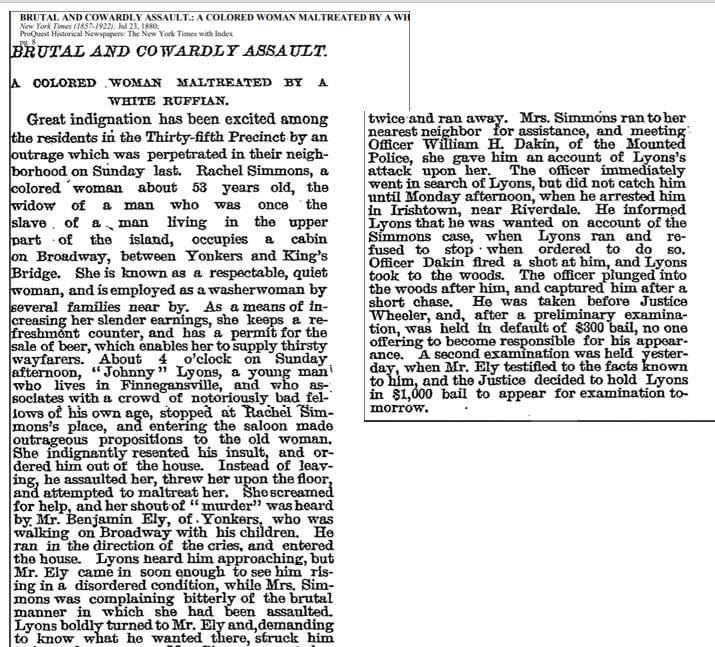
It is a fascinating story on its own but I was excited to learn a little more about Rachel Simmons. The Simmons family showed up on my radar before as I was researching for the “Part 2” of my article about the historic Black community in our area (that “Part 2” is still in the works by the way). The Simmons are an interesting family as their history can be traced from slavery in our part of New York to the 20th century–and hopefully to the present.
Stephen Simmons, a coachman and Rachel’s husband, first shows up in records in 1833 as far as I know. That is when he purchased a quarter acre of land in Riverdale from Samuel Lawrence. Most Riverdalians today are probably familiar with the location:
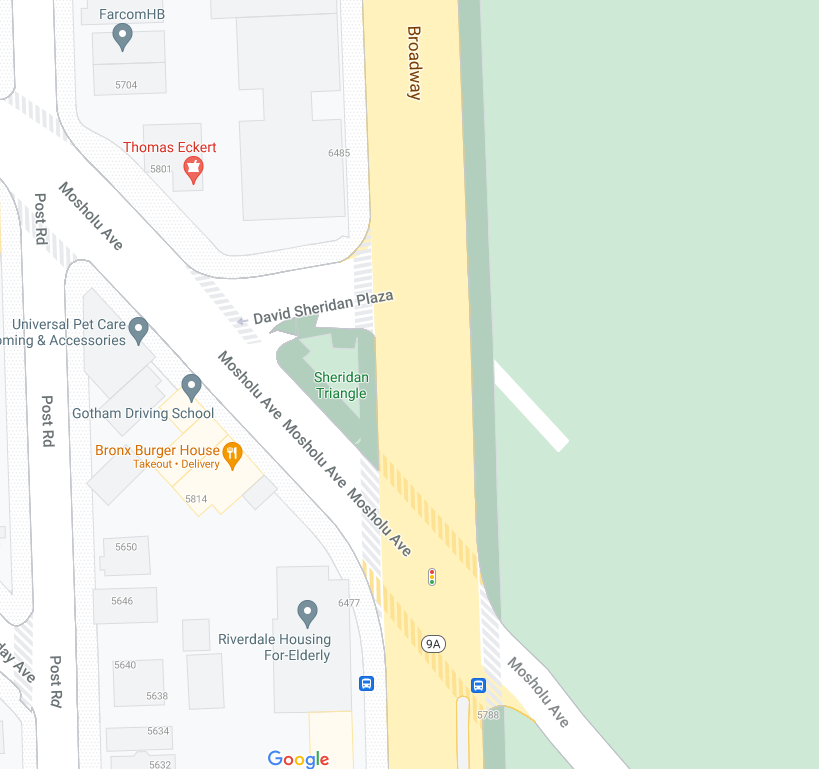
This is the intersection of Mosholu Ave and Broadway. Notice the little triangle of land named Sheridan Triangle. In this area was the small slice of real estate purchased by Stephen Simmons in 1833. This 1851 map of the area mistakenly labels two local homesites as belonging to “C Simmons.”
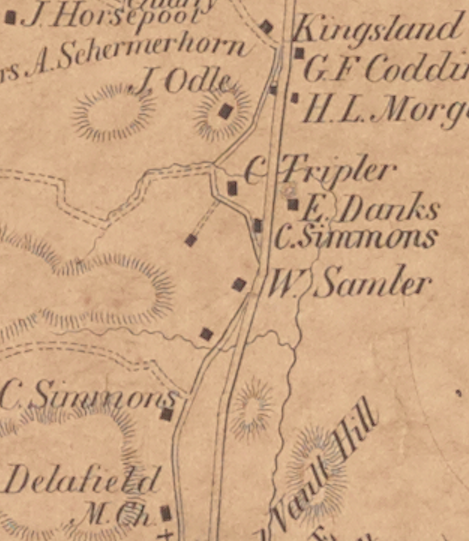
1851 Sidney & Neff Map The other Simmons family was in the household of Charles Simmons, a bonnet maker from England. His home was the one to the south (about where Riverdale Country Day School’s athletic fields are today). The house to the north was the home of Stephen and Rachel Simmons and should have been labeled “S Simmons.” Local land deeds describe the property as being in a triangle between the Old Albany Post Road and the Highland Turnpike. The Old Albany Post Road is the original windy road on the west side of the Simmons house in the above map. Part of that road is today’s Mosholu Ave near where it intersects with Broadway. The Highland Turnpike is what became Broadway. You can see it running on the east side of the Simmons house in the above map. So that house was in a triangle that still exists today even though the names of the roads have changed. The turnpike was built in 1806 as a much needed upgrade to the bumpy, narrow, and muddy Albany Post Road. In fact, that section of roadway just to the west of Broadway at Mosholu Ave had the evocative name of “Breakneck Hill.” So, you can see why the Highland Turnpike Company would want to adjust the course of the road in this area.
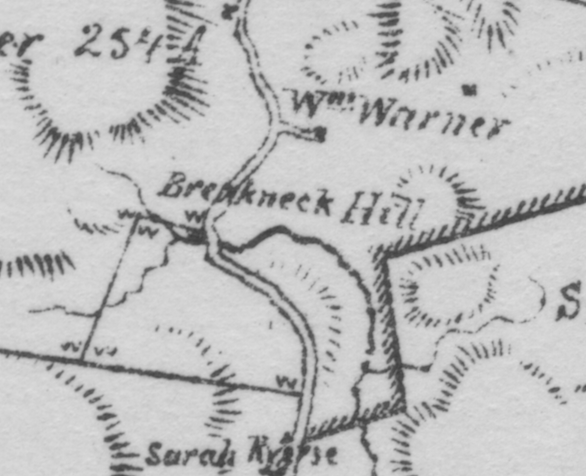
1785 property map showing the course of the Old Albany Post Road before the building of the “Highland Turnpike,” better known as Broadway today. The turnpike was likely built farther to the east of the Albany Post Road to avoid “Breakneck Hill.” Just to be clear, it was exceedingly rare for a free Black person to buy land in our area in those times as Stephen Simmons had done. The deed for his 1833 purchase is the earliest one I have ever seen in our area. It had not even been a decade since slavery was officially abolished in New York. In addition to the land he purchased, Simmons also leased additional land from the Van Cortlandts. It would be interesting to know who enslaved Stephen Simmons. According to the article he was formerly the “slave of a man living on the upper part of the island [Manhattan].”
The 1840 census for Yonkers (which included Riverdale at the time) includes 5 free Black people living at the household of Stephen Simmons, but does not list all of their names. The 1850 census shows the following:

You can see that Rachel Simmons was Rachel Brown before her marriage to Stephen and that she came from Virginia. Note a child, Matilda, living in the home. Interestingly, living in the next house down was another free Black man named Peter Pierson. I believe he is the same Peter Pierson that was manumitted by Alexander Macomb, who operated a major milling facility on the Spuyten Duyvil Creek. Part of me wonders if Peter Pierson hadn’t been purchased by Macomb from Augustus van Cortlandt, who held an enslaved miller named Piero on their plantation in today’s park. Piero had a son named Peter and the name “Peter Pierson” has an uncanny resemblance to “Peter Piero’s son.” This is also near the home of the free Black Sickles family suggesting that the free Black families clustered together close to today’s Broadway near Mosholu for some reason.
The 1880 article states that Rachel Simmons ran something like a saloon and was “employed as a washerwoman by several families nearby.” This jibes with this blurb in an 1873 edition of the Yonkers Statesman newspaper.
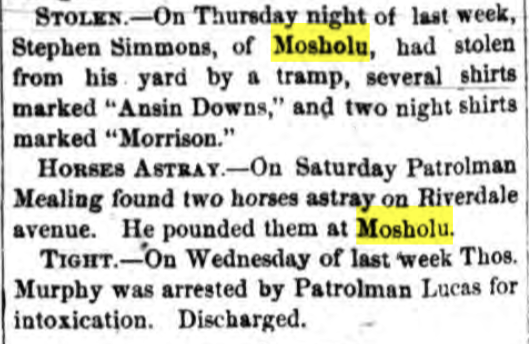
Note the other story at the bottom of the above clipping. Drunkenness and crime was an issue in the neighborhood in those years in keeping with the 1880 New York Times story. In 1870 the Yonkers Statesman reported that at “19 out of 20 houses liquor could be obtained.” There are some very ugly stories involving alcohol abuse in that time in our area. Speaking of 1870, in that year Stephen Simmons was still alive but getting older according to the census below. Rachel is there too and there are even more children. Stephen is the only person listed with a “B” for Black. The others are “M” for mulatto.

Among the children of Stephen and Rachel Simmons was a boy named Raymond Simmons, who was born in 1865. Interestingly, a Black man named Raymond Simmons born in 1865 appears in the 1900 New York State Census for Yonkers. He lived with his wife Eliza and his daughter Maud:

A Black woman named Maud, possibly the daughter of Raymond Simmons, shows up in the 1915 state census for Yonkers. She was married to John Wheeler, a coal wagon driver, with four children. I believe they lived at 41 Garden Place in Yonkers.

It would be fascinating to see if living descendants could be found of Stephen and Rachel Simmons, former locally enslaved people who ran a saloon and laundry on their own land in Riverdale. If anyone is interested in following up on this research, please get in touch.
-
July 9, 2021 at 2:08 am #2053
My gosh this is amazing detective work.
I’m curious to know where Finnegansville and Irish Town were
-
July 9, 2021 at 3:18 am #2054
From John McNamara’s History in Asphalt :
Finnerganville small settlement on eastern slope of W 246th st from Riverdale Ave to Broadway.
Irish Town settlement of 19th Century at West 258th St and Riverdale Ave – also aka Coogan’s Alley. Today dead end street with a number of old private homes from that period.
-
July 10, 2021 at 12:25 am #2055
Good old History in Asphalt–a good book to have!
I went and looked in the 1880 census and there is a street labeled “Finnegansville East Riverdale Ave.”
The first person listed is John Finnigan, a 67 y.o. farmer from Ireland. The rest of Finnegansville is composed of 1 person from England, 4 New Yorkers, and 38 Irish immigrants or children of Irish immigrants. Every single person listed as living on Mosholu Ave was an Irish immigrant or the child of an Irish immigrant. Irish Town indeed!
-
July 10, 2021 at 4:11 am #2056
This was a great read! Thanks for all the research.
-
February 8, 2024 at 7:25 pm #3885
John McMenimon, a teacher in Yonkers, recently reached out to me with regard to the family of Stephen Simmons. John thought to contact the Episcopal Diocese of New York to learn if free Black people living in Yonkers were buried at St. John’s Cemetery. St. John’s Church in Yonkers was the local Anglican church for our area during the colonial period and beyond. He found Stephen Simmons listed as having died on December 24, 1874 at the age of 84. The cause of death was consumption (on the last row below):
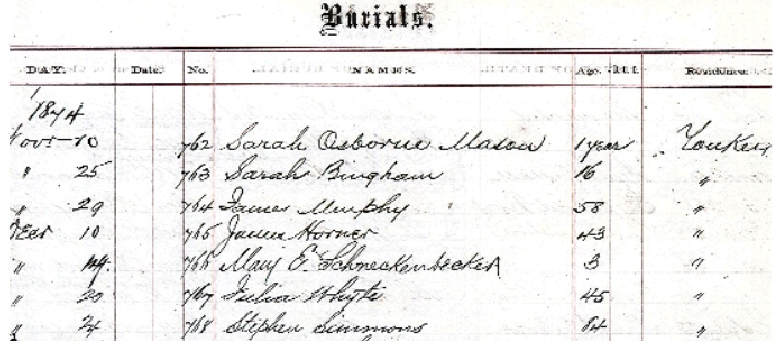
From some of the other names on the documents, it is clear that many Kingsbridge/Riverdale residents were interred at St. John’s Cemetery, which is in a historic district in Yonkers (across the street from the Alexander Smith Carpet Mills) in the Saw Mill River valley.
St. John’s Church goes back to 1752. That is where the Van Cortlandts and other local families went to church. The pastor there during the American Revolution, Luke Babcock, was a loyalist who was imprisoned by Patriot revolutionaries. He died shortly after being released and was interred in the Van Cortlandt Family Burial Vault in Van Cortlandt Park.
-
-
AuthorPosts
- You must be logged in to reply to this topic.